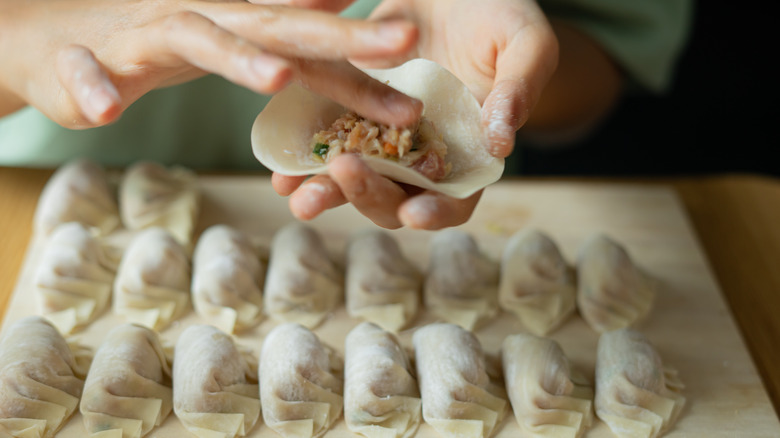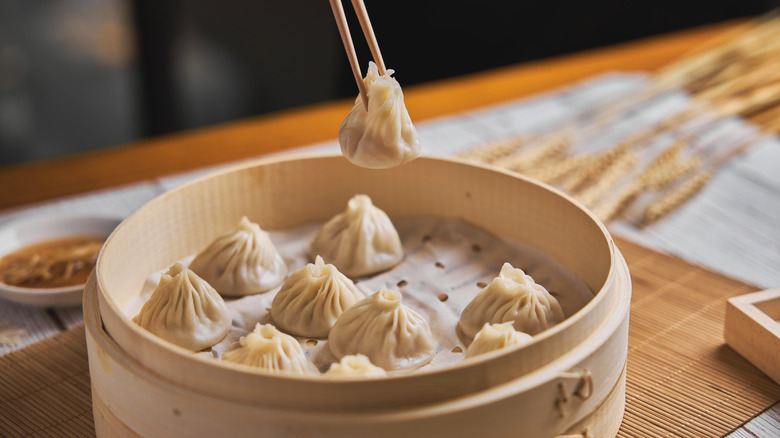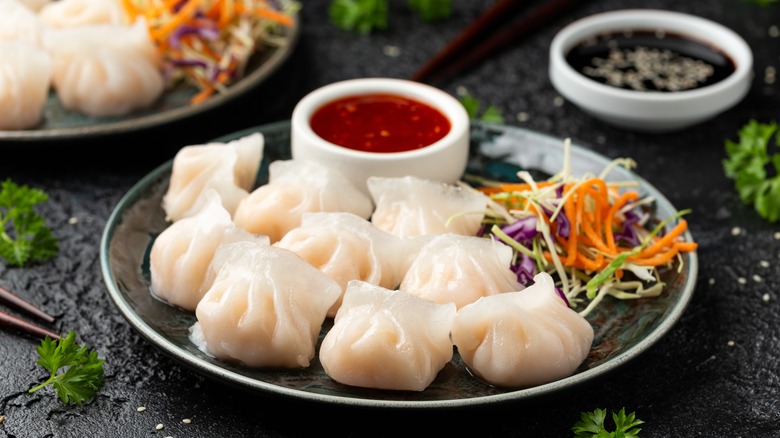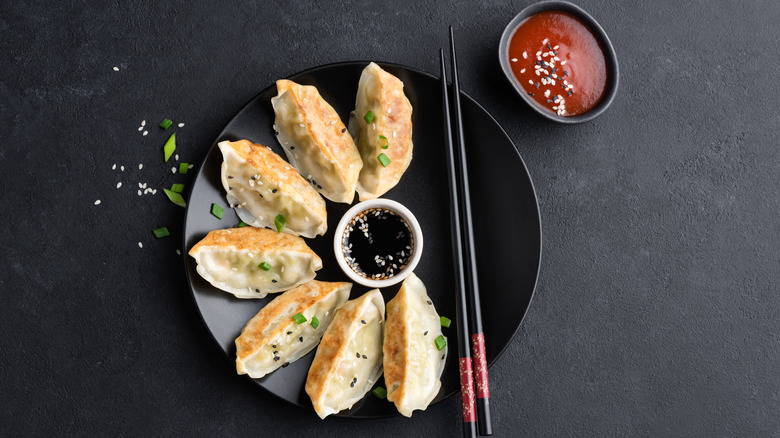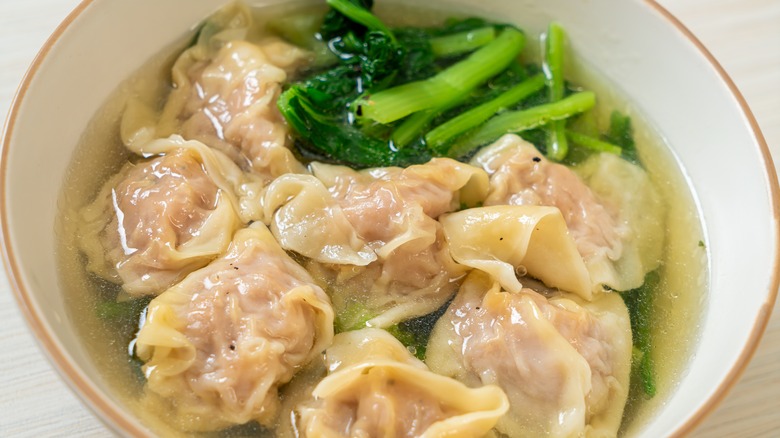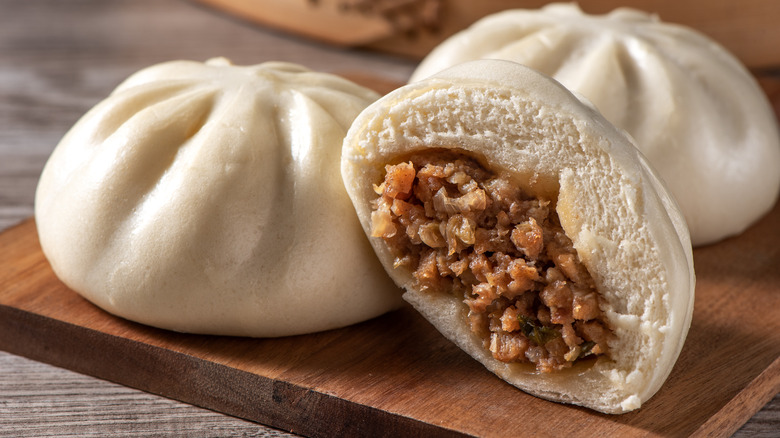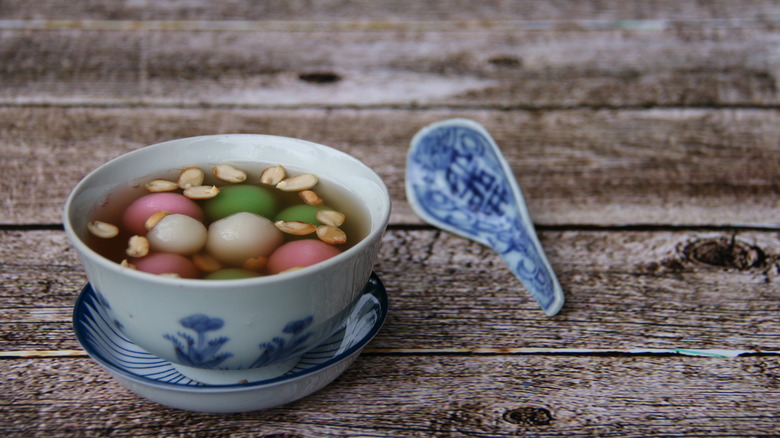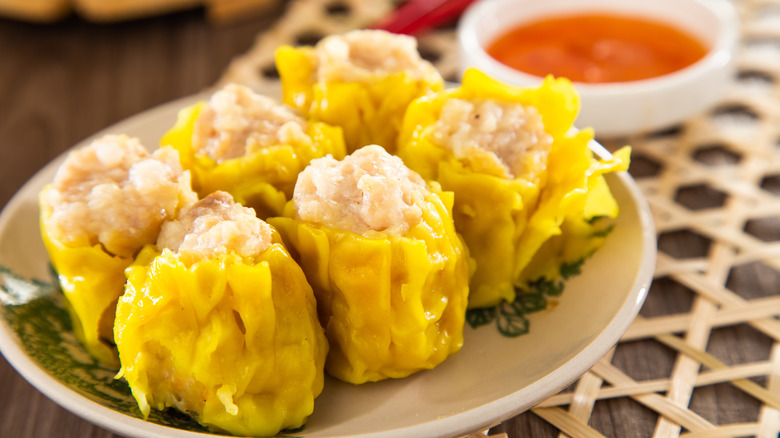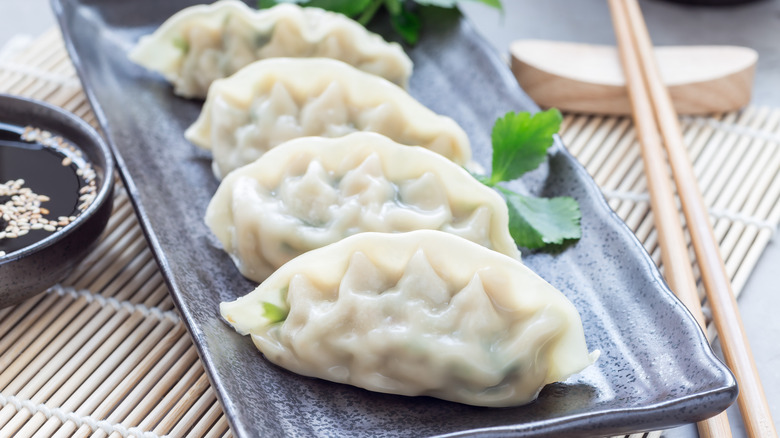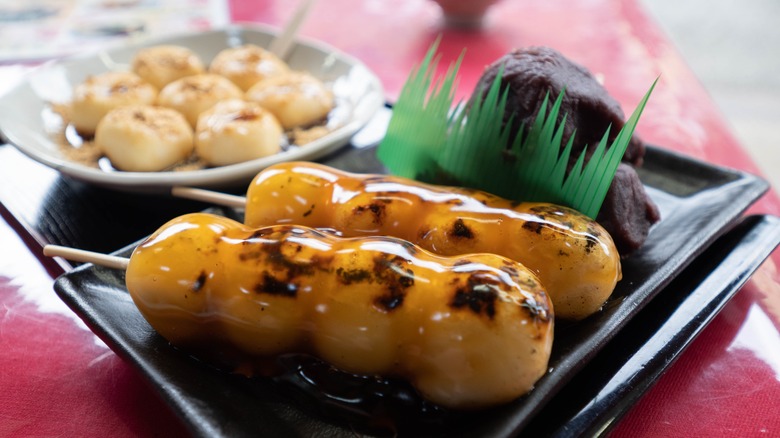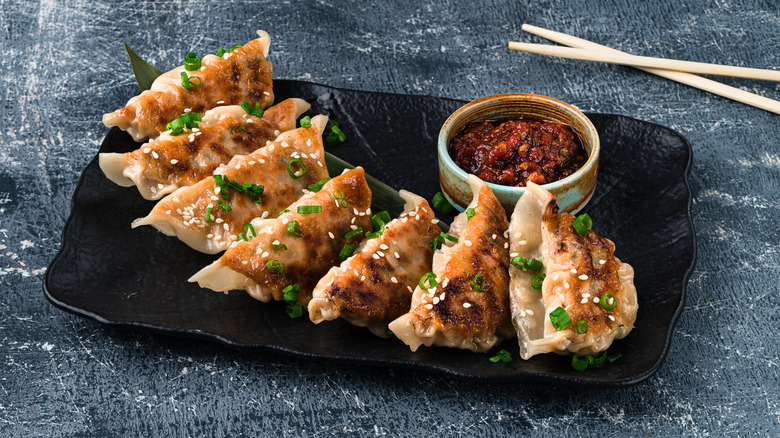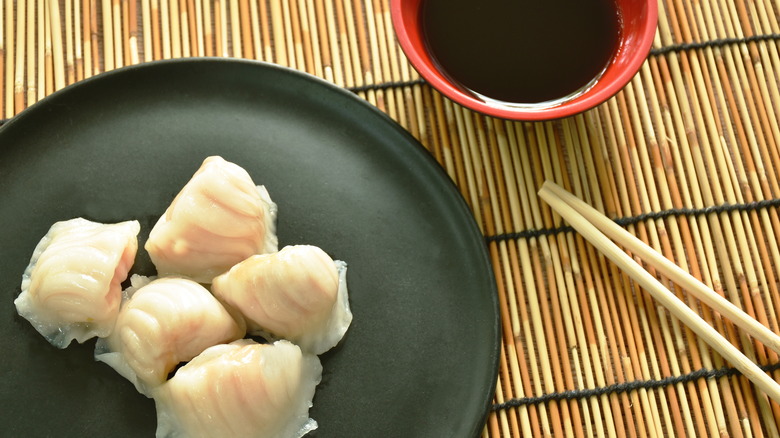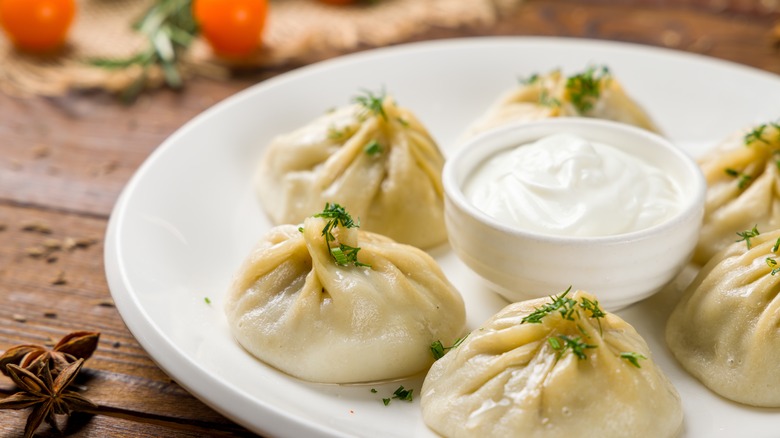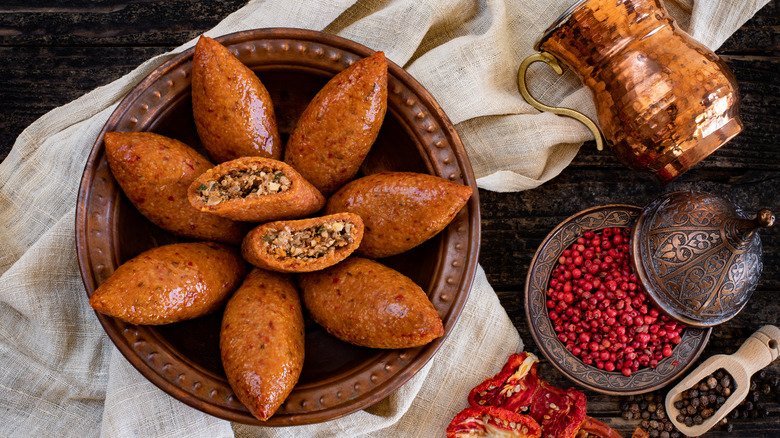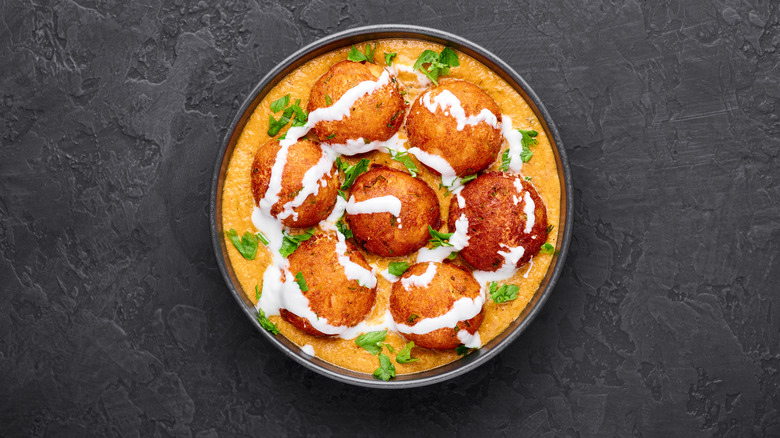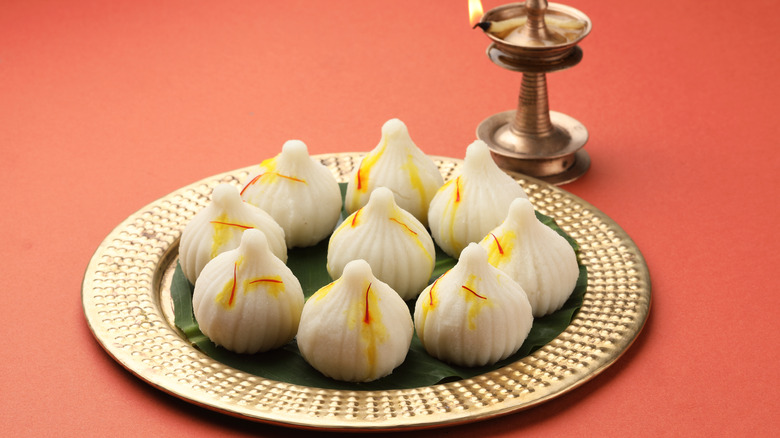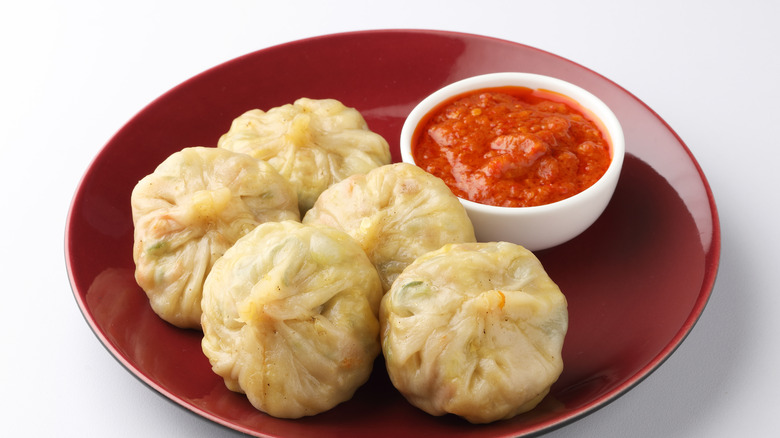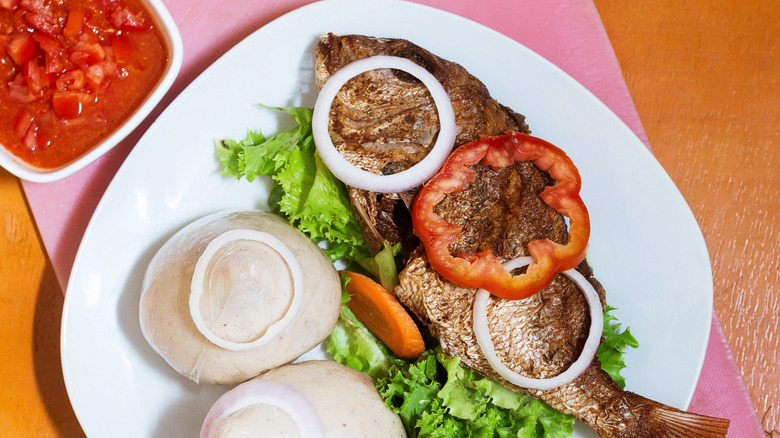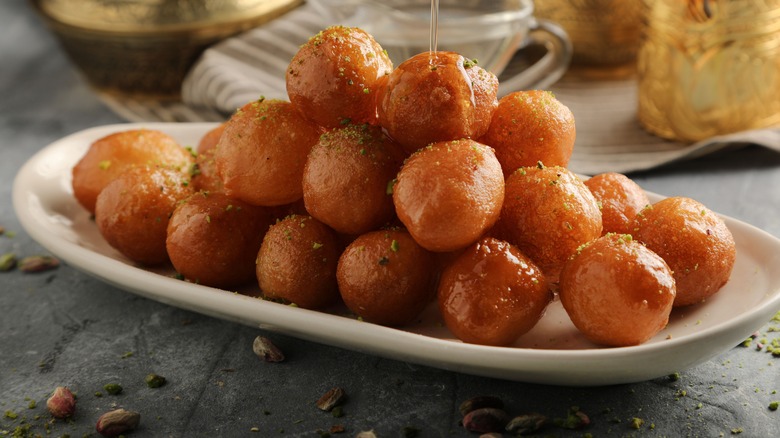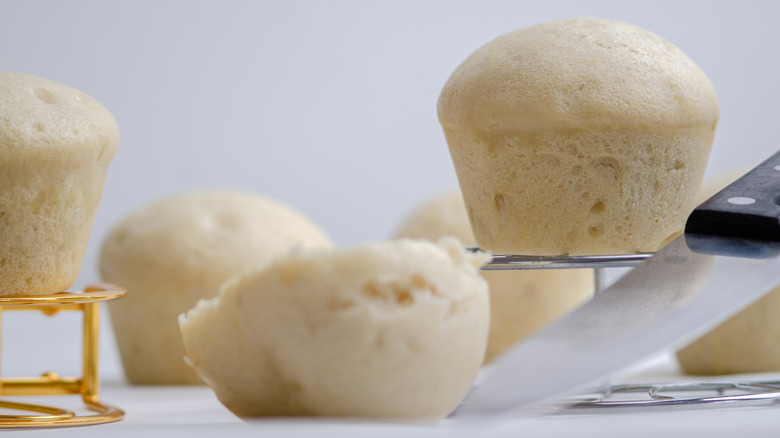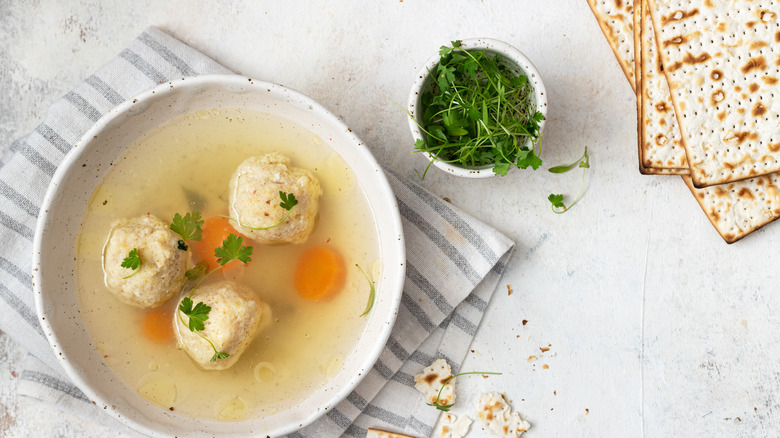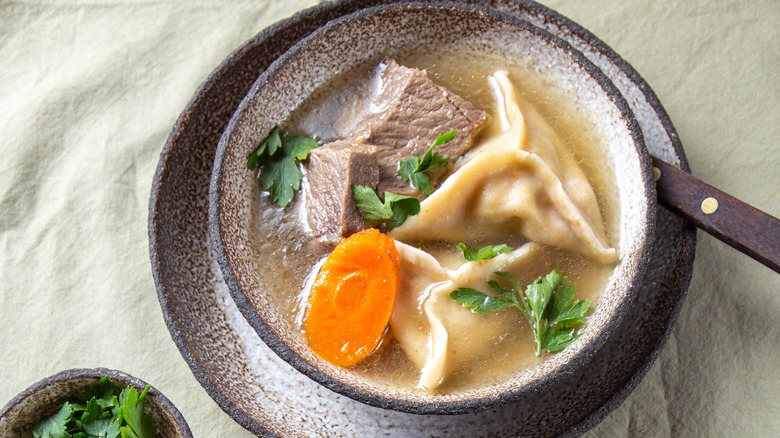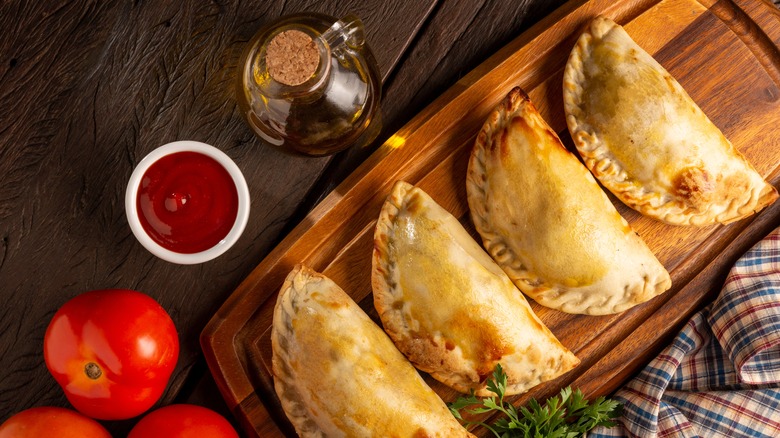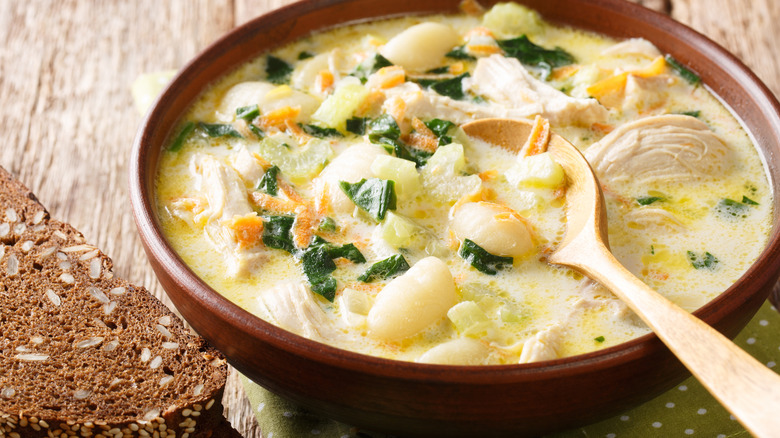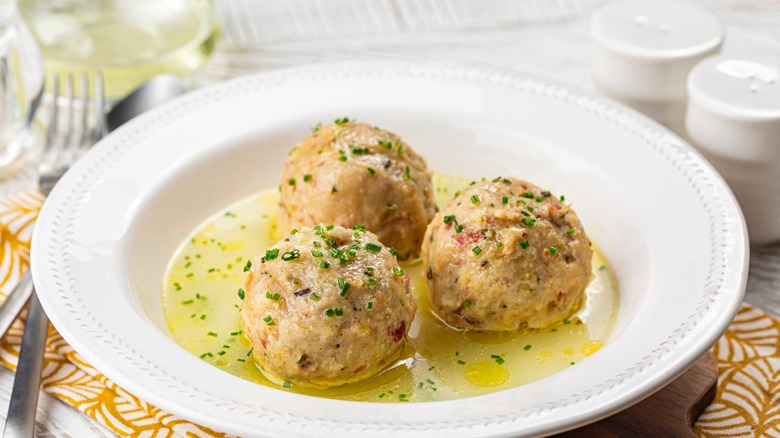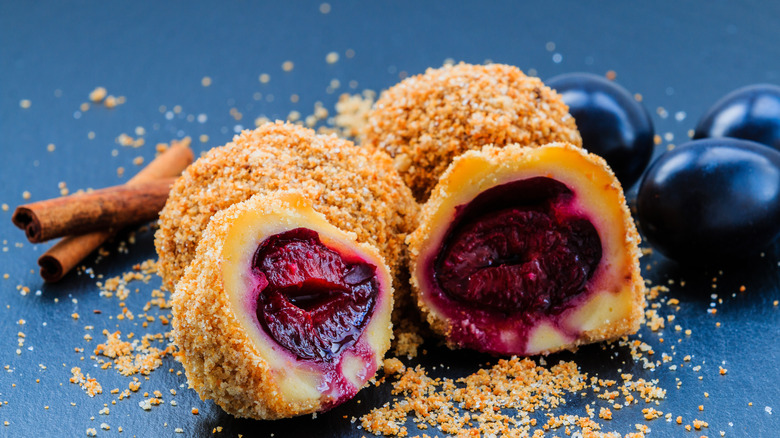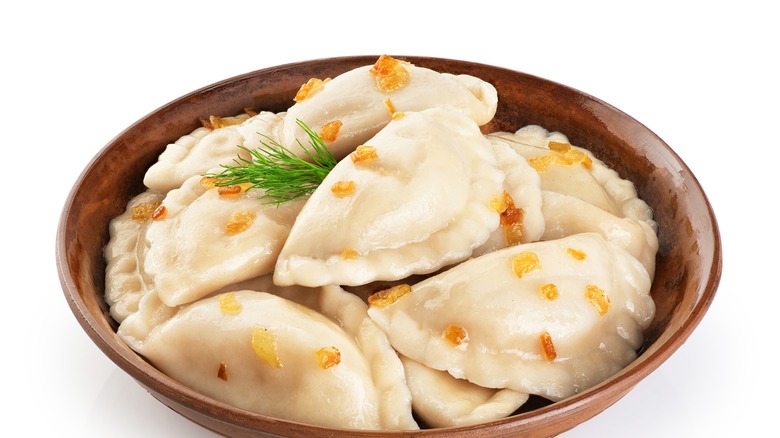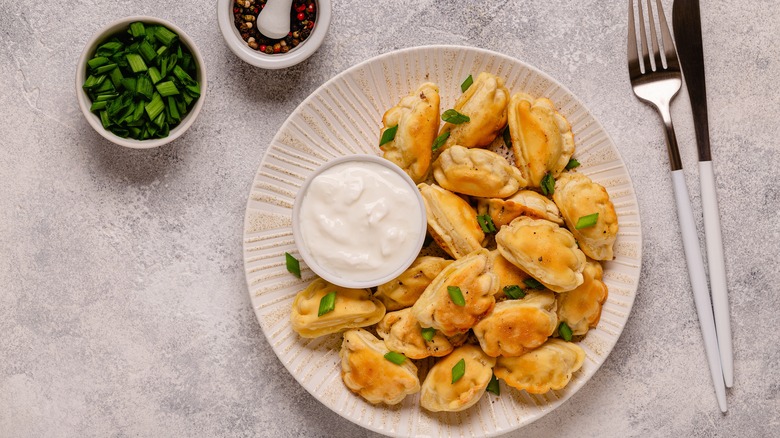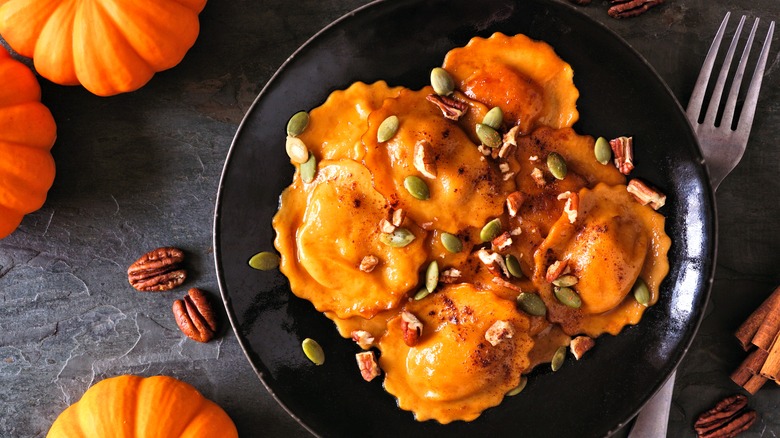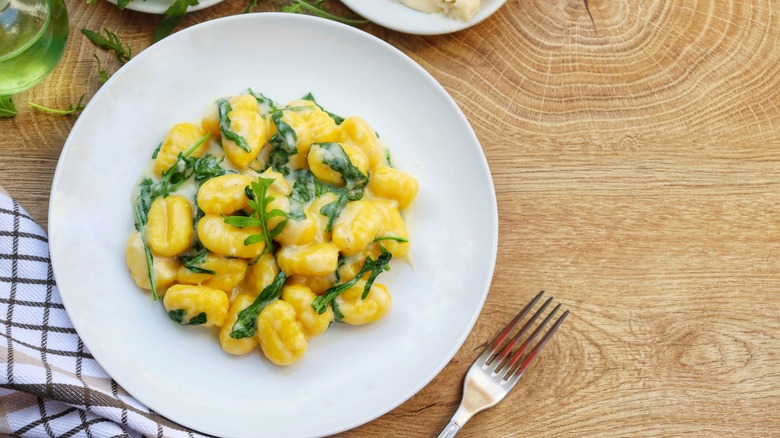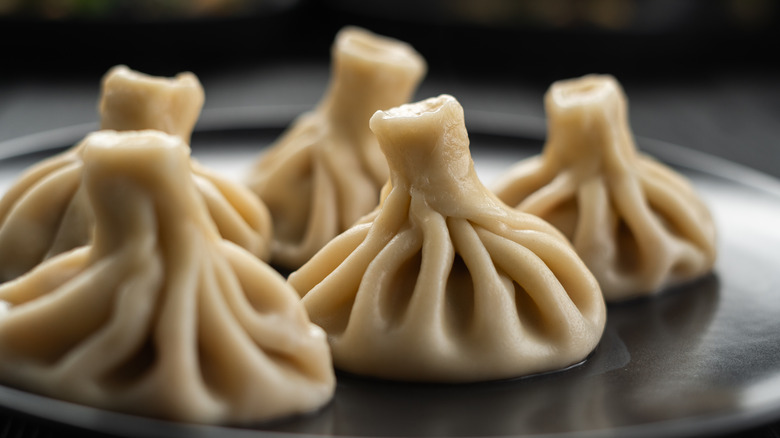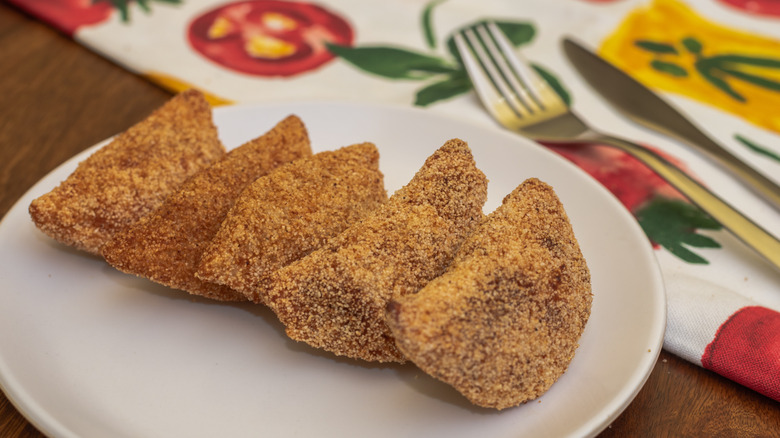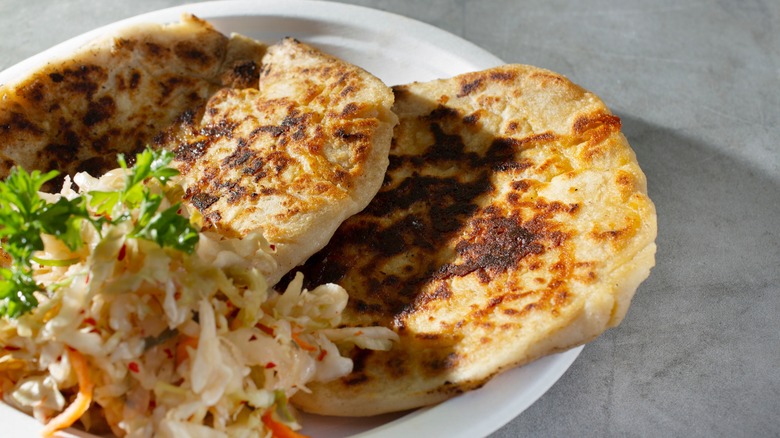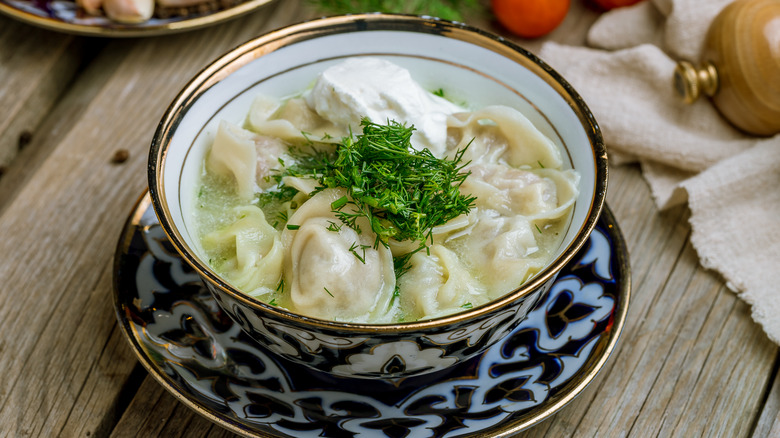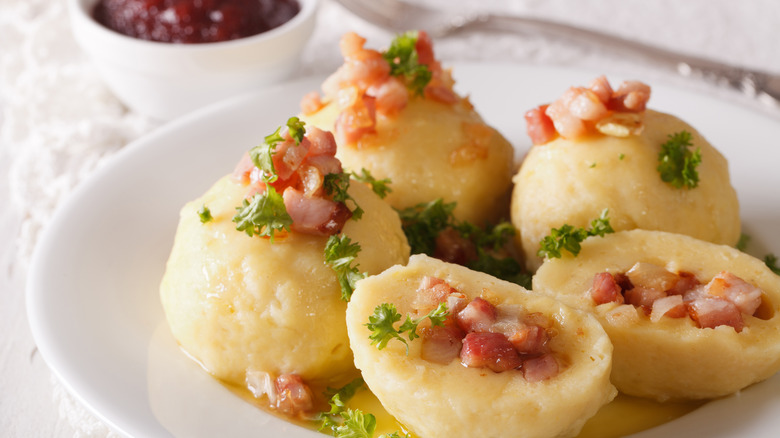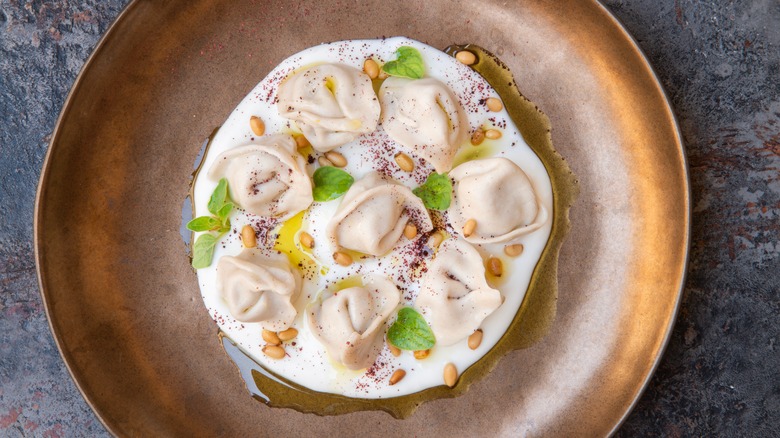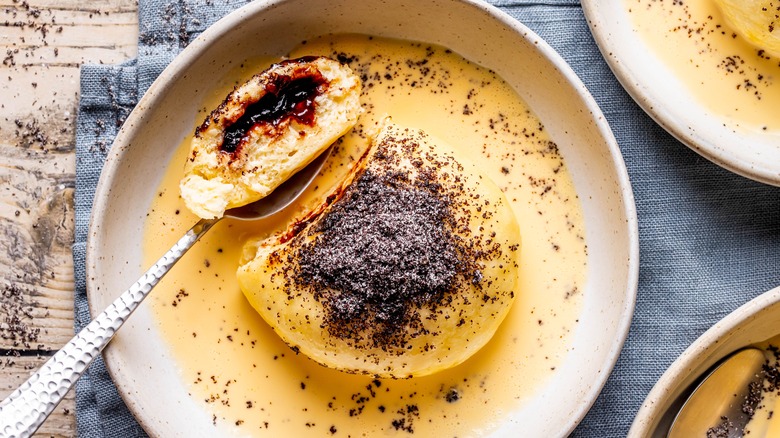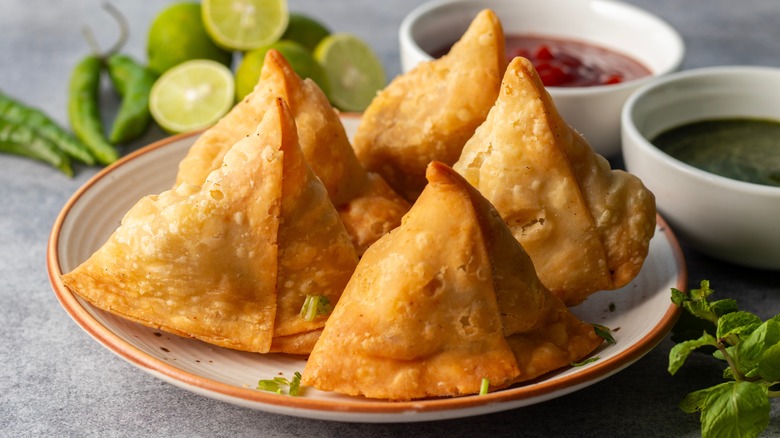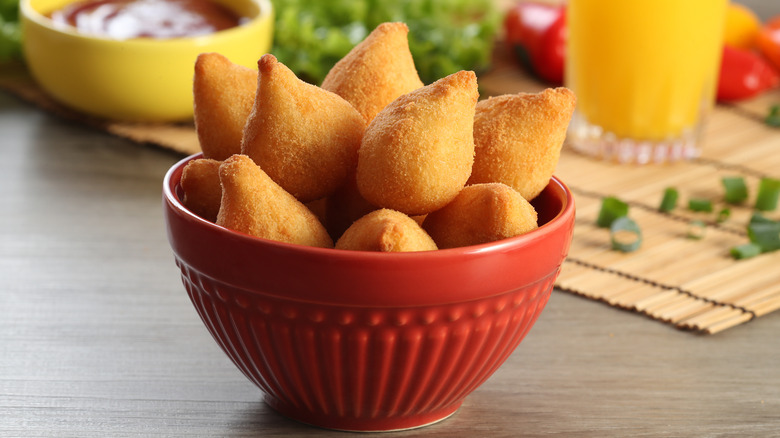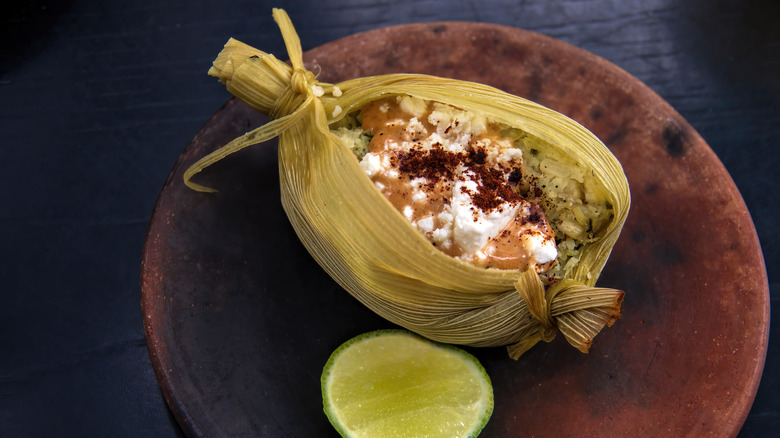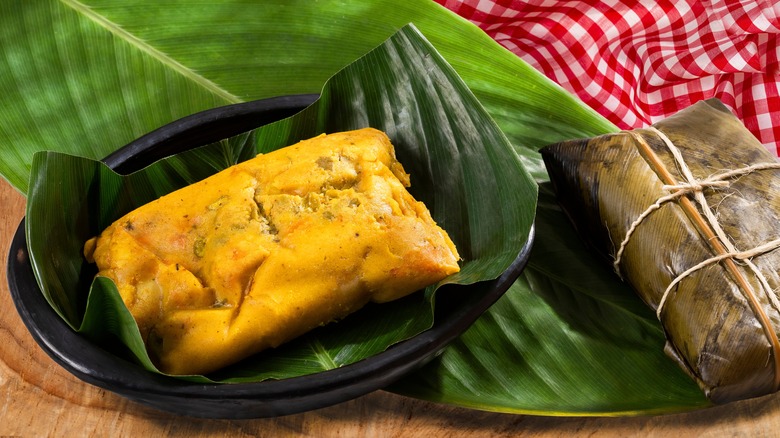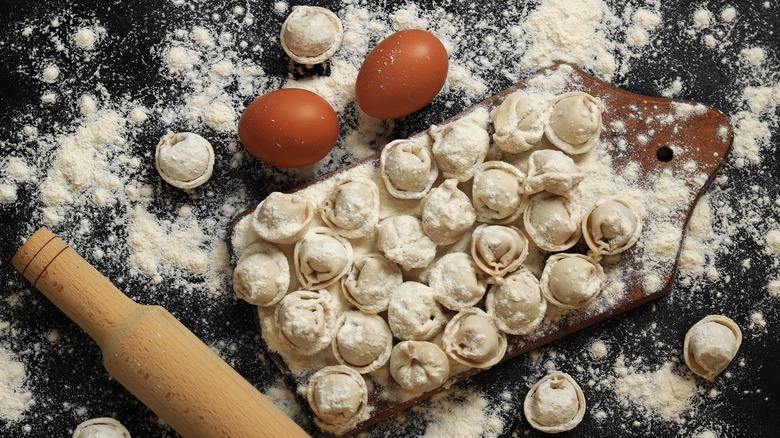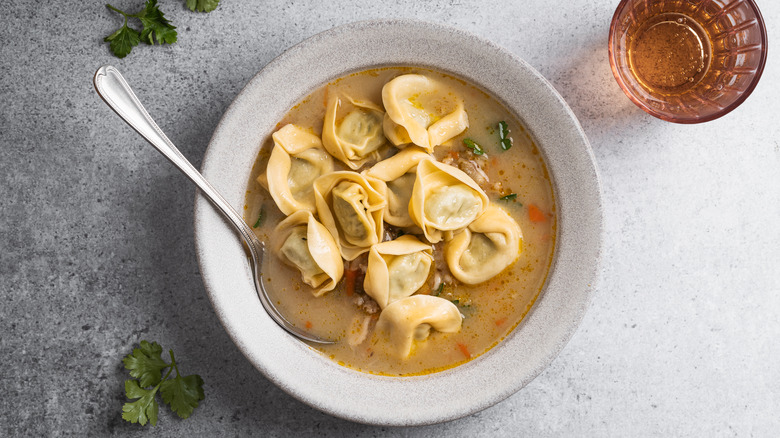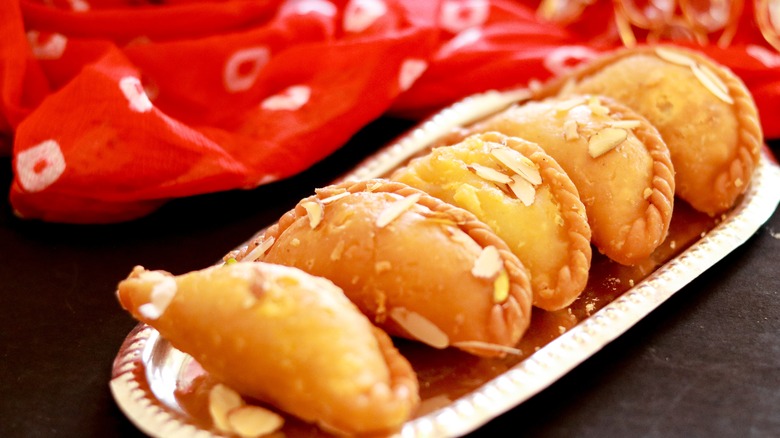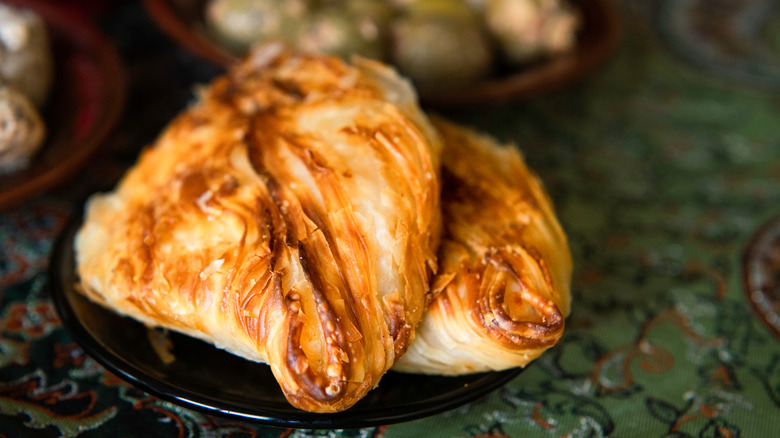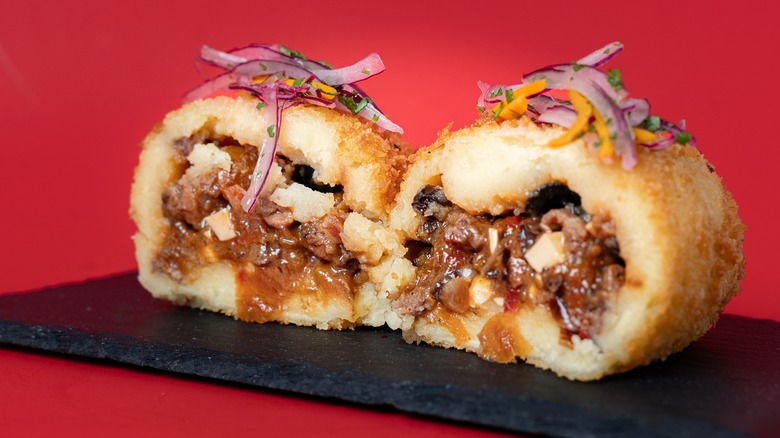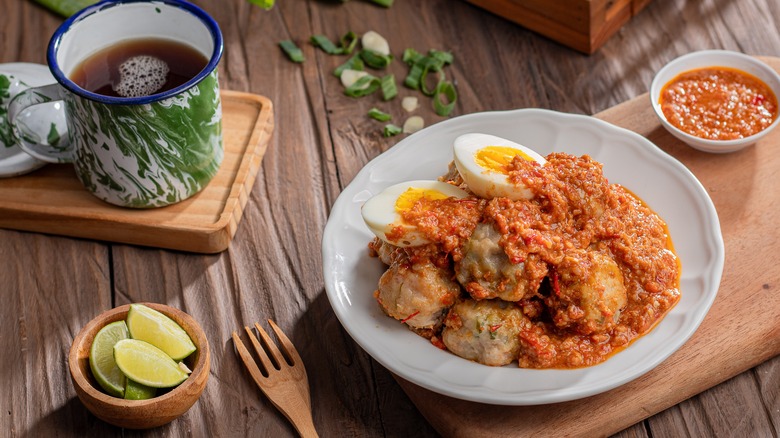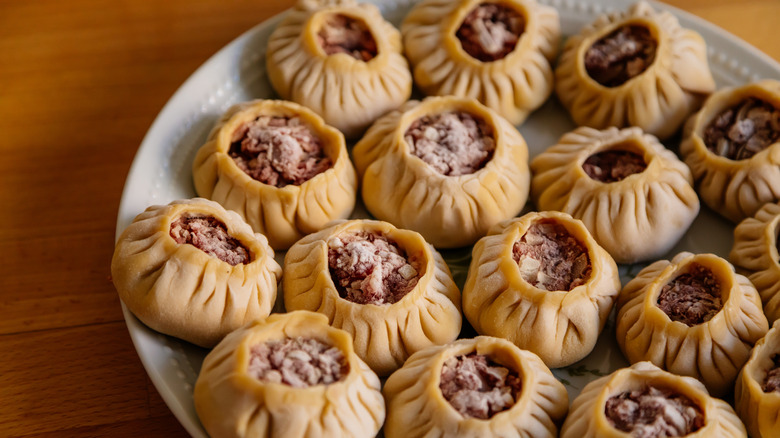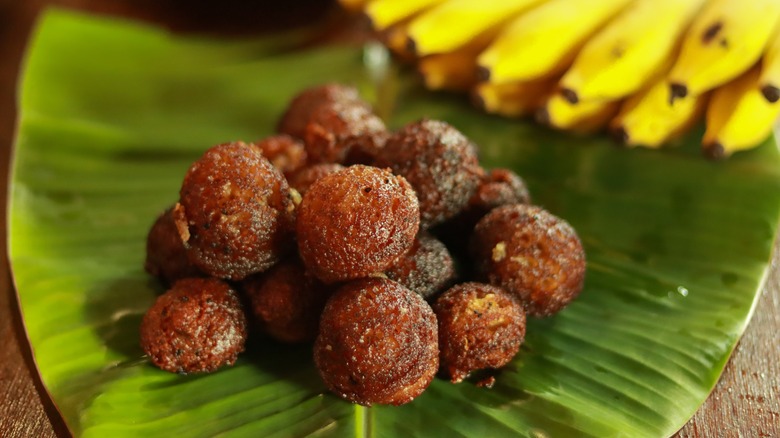50 Types Of Dumplings, Explained
We may receive a commission on purchases made from links.
What is the definition of a dumpling? The image that comes to your mind may be of dim sum and baskets of shumai, but don't restrict yourself to Chinese dumplings, as delectable as they are. There are many types of dumplings around the world, utilizing different shapes, sizes, and techniques on all continents. In fact, most cultures have some form of dumpling that serves as a staple in their cuisine.
So again, we ask: What is the definition of a dumpling? A dumpling usually entails a pocket of dough stuffed with a filling — but then, how do you explain such wonderful dumplings as dango or matzo balls? To fully answer this question, we created this list of dumplings. Its vast variety and deliciousness — encompassing all sorts of dumplings from all reaches of the world — are for you to explore. By the end, you'll have a better idea of what dumplings are ... and you'll probably be ready to eat a whole plate of them.
Xiao long bao
Xiao long bao, also known as soup dumplings and lovingly referred to as XLB by true fanatics, is a dim sum staple. These dumplings, which usually arrive steaming hot in a bamboo basket, are delicate yet chewy and complex. The secret to this dumpling, which originates from the Chinese province of Jiangnan, is in the soup, usually made from pork gelatin and collagen.
When steamed, these gelatinous bits transform into a soup within the dumplings. With ideally 18 pleats and the perfect ratio of meat to dough to soup, xiao long bao are a well-loved type of dumpling around the world.
Har gow
Another dim sum staple is har gow. Har gow is not only delicious but also stunningly beautiful. With an almost translucent wrapper and a light pink shrimp filling, har gow are delicate and absolutely divine. The filling, made from shrimp and flavored with oyster sauce, white pepper, and ginger, is fairly straightforward.
The difficult part of this dumpling is in the wrapper. Made from tapioca starch and wheat starch, along with fat and boiling water, getting the proper consistency for the wrapper is a journey, but one that is well worth it.
Jiaozi
These dumplings are iconic and deeply embedded in Chinese cuisine. Usually filled with pork and other seasonings like ginger and scallions, jiaozi can take on many flavors. Regardless of the filling, jiaozi is deeply important to Chinese celebrations, especially Lunar New Year.
The word jiaozi sounds like the phrase "transition from old to new," making them an essential Lunar New Year dish to celebrate new beginnings. Furthermore, the shape of the dumplings resembles gold ingots, making jiaozi also representative of wealth and good fortune.
Wonton
Wontons are another dumpling that hails from China. These wonderful little packets can be filled with all sorts of ingredients, from pork to shrimp to tofu, and are incredibly comforting when floating in a large bowl of wonton soup.
You may know these dumplings best in their soup form — as this is one of the most delicious ways to enjoy them — but they are also wonderful when deep-fried. This method brings delightful crispiness to the wrapper, which makes them chewy, soft, and crunchy.
Baozi
These dumplings, the first on this list that may make you wonder about the definition of dumplings, are made from wheat dough like many other dumplings. However, what sets baozi, also known as bao buns, is that the dough is made with yeast. This means that when the buns are steamed they rise into fluffy bread.
While baozi is often filled with pork, it can be stuffed with anything. In fact, these fluffy dumplings would be fantastic with some chocolate or mushrooms inside, but, of course, not together.
Tong yuan
Ah, so chewy, so sweet, so delightfully warm and comforting; nothing is quite as satisfying as tong yuan. Traditionally, tong yuan are enjoyed for the Lantern Festival, which falls on the 15th and final day of the Lunar New Year.
Consisting of a sweet filling — sesame and bean paste are popular — surrounded by a chewy rice dough, these dumplings would not be complete without the warm soup they are served in. Tong yuan are time-consuming, not to mention sticky, to make, but my goodness, they are delicious once you get it right.
Shumai
Maybe one of the most beautiful and technically difficult dumplings to make, shumai are not all looks — they also taste delicious. While an open-faced dumpling may not make sense to some, do not worry, shumai have special powers. Their delicate yet firm folding keeps the filling inside, resulting in a gorgeous dumpling that almost resembles a crown.
Made with a wheat wrapper and often filled with either pork or shrimp, shumai is steamed and served piping hot. Enjoy your shumai with a nice dipping sauce to balance the flavors in the filling.
Mandu
Mandu varies greatly from household to household in Korea. However, while individual recipes may vary, there is a general consensus that everyone loves mandu.
These dumplings, which are commonly filled with pork, can also be filled with vegetables or other meat and are delicious cooked in many ways. Maangchi recommends boiling, steaming, or frying any mandu you make. And, of course, if you ever have any leftovers, make sure to freeze them for the future.
Dango
These dumplings are also not exactly what may come to mind when you hear the word dumpling, but that does not make them any less irresistible. Dango, made from rice flour, are small balls of dough that have been rolled and boiled. But they're not actually filled with anything.
This might throw lovers of traditional dumplings, but they still deserve a taste. Dango is usually served grilled with a sweet soy sauce, which makes it a perfect street food and a most satisfying snack.
Gyoza
Gyoza, which resembles Chinese jiaozi, is actually related. Probably the most famous Japanese dumpling, gyoza originated in China and is now enjoyed all over the world, where they are also known as potstickers.
These dumplings, like many others, can be filled with just about anything. Better yet? They can be cooked in multiple ways too. You can steam, deep fry, or pan fry your gyoza. But if you ask us, getting that crispy, alluring brown crust is always the way to go.
Bánh bôt loc
Somewhat similar to har gow, bánh bôt loc also expertly utilizes shrimp to make the most delicious dumplings. Originally from Vietnam, these dumplings celebrate the sea and the land, using wrappers made from tapioca flour and the most delightful combination of shrimp and pork.
The irresistible bounciness and chewiness from the wrappers, combined with the satisfying chew of the filling, make bánh bôt loc one of the best dumplings around. Don't believe us? Guess you'll have to go out and try some for yourself.
Mantu
Mantu has a rich history and originates from Afghanistan. Many surrounding countries have similar dumplings, all of which were brought through the silk road by Turkic and Mongol traders.
These dumplings are traditionally filled with beef flavored with onions, cilantro, and coriander. A dollop of filling is placed in the middle of a square wrapper, and all four corners are brought together into a light pinch at the top. Before being devoured, mantu are best dipped in a yogurt sauce which brings both creaminess and tang.
Kibbeh
Kibbeh is the first dumpling on this list to be made without dough. Essentially, kibbeh is similar to croquettes, with a crunchy outer layer that has been deep-fried. The "dough" part of kibbeh is made from bulger wheat mixed with ground beef or lamb. This dough is then stuffed with more meat cooked down with onions and pine nuts. The kibbeh is then deep-fried and enjoyed as a delicious snack or appetizer.
Malai kofta
North Indian Malai kofta are crispy, warm, and irresistible. These dumplings, which are not filled but are no less delicious, are balls of paneer, vegetables, and potato that are deep-fried. They are then soaked in a gravy sauce, usually one that is incredibly creamy and rich. They're the perfect comfort food to accompany rice or naan.
Modak
Another dumpling from India, modak is perhaps the perfect way to end a meal. These dumplings, which come from the west Indian state of Maharashtra, are made from steamed rice flour that is filled with jaggery and coconut.
They are sweet, chewy and have a delightful bite thanks to the shredded coconut. On top of that, the jaggery, also known as raw cane sugar, brings a wonderful caramel flavor to the modak, making the whole dessert absolutely delicious.
Momo
These dumplings, which are very beloved in Nepal and surrounding areas, are wonderfully chewy and pair perfectly with a spicy achar sauce. Momos, which can be stuffed with anything, are most often filled with buffalo meat and aromatics like ginger and garlic.
What makes momos so irresistible is their all-purpose flour wrapper that becomes dense and chewy after steaming and the flavor combination of filling with achar sauce. Achar sauce is made from tomato, chilis, ginger, garlic, and cumin.
Banku
Banku, fairly similar to fufu, is a dumpling made from fermented corn and popular in west Africa, specifically Ghana. These delightful dumplings are labor-intensive to make, but when served alongside okra stew or a piece of grilled fish, their soft corn flavor truly completes the meal.
To make banku, you start by fermenting the corn for 2-3 days, then grind it into a dough, and finally roll it into balls and steam it for eating. The sour taste of the dough, which comes from the fermentation, ensures that it pairs wonderfully with savory and spicy stews.
Kaimati
Who doesn't love a ball of fried dough? During Christmas time in Kenya, these dumplings are a staple. Made from wheat flour and baker's yeast, kaimati resemble yeast doughnuts but are slightly denser thanks to their shorter rising time. Once the balls are fried, they are soaked in cardamon and vanilla syrup before being devoured in the true holiday spirit. These dumplings are sweet, chewy, indulgent, and downright irresistible.
Dombolo
Dombolo means dumpling in Spanish, but in South Africa, where these dumplings originate, the final food is considered more of a steamed bread or bun. These buns are made with wheat flour and yeast and are commonly eaten for breakfast.
In Zulu tradition, it is also common to see dombolo eaten on top of stews. The dombolo, in this case, are called ujeqe, and are delicious when served with a savory bean stew called ubhonsisi.
Matzo balls
Matzo balls make for the ultimate comfort meal. These soft, squishy, and slightly chewy dumplings, found in a warm and comforting broth, are a staple of Jewish food. Most commonly made for Passover, matzo balls are made from matzo meal, which, surprise, surprise, is made from matzo, an unleavened wheat bread. These dumplings are like a big hug, and full of the broth's rich flavor.
Kreplach
Kreplach resembles other soup dumplings — think wontons or even mandu — but what sets these wonderful Jewish dumplings apart is their dough. The wrappers are generally made with pasta dough, making the final dumplings very similar to other types of stuffed pasta, such as agnolotti. However, with any age-old recipe, kreplach varies from family to family and region to region.
While chicken is a popular filling, other versions may feature vegetables, brisket, or even cheese. If not eaten in a soup, they are often topped with sour cream and can even be garnished with nuts for additional texture.
Empanada
The empanada is one of the most divine versions of hand pies. Filled with anything from meat to cheese to corn and then either baked or deep fried, these dumplings are delectable, boasting a crunchy crust and soft filling. While the origins of empanadas are Spanish, today, empanadas are most associated with South and Central American cuisine.
You can find empanadas in markets, grocery stores, on the street, and in many households, being served for a meal or snack. The flakey pastry combined with a salty, chewy inside makes these little pockets absolutely irresistible.
Drop dumplings
Somewhat like matzo balls, drop dumplings consist of dumplings that are served in a soup, most commonly chicken soup. And how do you make them? Just as their name suggests, drop dumplings entail dropping the dumpling dough into your simmering soup. Then, after only a few short minutes, your comforting and delicious meal is ready to be enjoyed.
However, unlike matzo balls and other soup dumplings, drop dumplings tend to sit on top of the soup. This can be attributed to the thicker soup that drop dumplings are usually placed into.
Semmenlknödel
Yet another dumpling that resembles both matzo balls and drop dumplings, German semmenlknödel, also known as German bread dumplings, are oh-so comforting and delicious. A specialty from Bavaria in southern Germany, these dumplings are made from stale bread, eggs, onions, butter, and parsley.
If this sounds a little bit like thanksgiving stuffing, then you're right on. These little balls utilize stale bread expertly, transforming it from a rock into something delicious. An even more decadent version, called speckknödel, includes bacon and is tastiest topped with gravy.
Zwetschkenknödle
Right next door to Germany, the Austrians have been whipping up these stunning dumplings for centuries. Unlike the other dumplings on this list, zwetschkenknödle is not only sweet; they actually contain a whole plum. That's right: To make these dumplings, you simply take the pit out of the fruit and then wrap the whole thing in a buttery dough.
The final dumplings can range in size, considering that plums do as well. When you cut into a zwetschkenknödle, the vibrant purple from the plums (unless you use yellow plums) is a show stopper.
Pierogi
One of the most beloved dumplings worldwide, who could be upset with pierogi? A beautiful combination of wheat, meat, potatoes, and sour cream, pierogies are an ode to starch in the form of incredibly savory comfort food. Originating from Poland, with look-alikes in Ukraine, Russia, and other eastern European countries, pierogi are loved for their simplicity and heartiness.
Usually filled with potato, cheese, meat, or a combination of all three, these beloved dumplings would not be complete without a dollop of sour cream and some sweet, caramelized onions on top.
Vareniki
Vareniki are very similar to pierogi but originate from Ukraine, where they are usually eaten with sour cream, butter, and fried onions. To top it off, some versions include bacon for an additional layer of indulgence. They are often folded with intricate pleating around the edge, which adds a layer of refinement to these delicious dumplings. These dumplings are enjoyed all year round but are especially popular for Christmas Eve dinner.
Ravioli
Ravioli is a beautiful word that rolls off of the tongue and a beautiful food that has taken over the world. These stuffed kinds of pasta, which can come in a variety of sizes and even shapes, have endless possibilities in regard to fillings. Do you prefer cheese, squash, meat, or spinach? You can choose any or all of the above with this versatile and satisfying pasta. Made with traditional pasta dough and then boiled and tossed in a sauce of your liking, ravioli truly is a fan favorite — and for good reason.
Gnocchi
Gnocchi has a similar chew to dango, pairs beautifully with cream like ravioli, and is a celebration of wheat and potatoes like pierogi. Usually made with potatoes and wheat flour that are kneaded together into a dough, gnocchi are so wonderfully chewy and dense that they satisfy even the pickiest.
The best part? These Italian dumplings are incredibly versatile and pair well with almost any sauce or cheese. They are also very fun to make and that much more satisfying to eat.
Khinkali
Khinkali is one of the 20 authentic Georgian dishes you need to try at least once. Filled with meat, onions, and often herbs like cilantro, these dumplings will dazzle you with their pretty shapes and textural layers. Juicy meat — commonly beef, pork, or lamb — contributes to the dumplings' signature soup-like filling, sometimes containing butter and broth. Khinkali are occasionally filled with vegetables, especially mushrooms. These dumplings are fun to eat: Hold onto their kudi (the top knot), take a small bite, sip the liquid, then pop the rest into your mouth. The kudi, which are often thick, are usually not eaten.
Knish
On a cold day, what could be more reassuring than a hot knish, the wheat-based Jewish dumpling filled with potato or kasha and served alongside a dollop of mustard? Specialty bakeries exist around the world in places touched by the Jewish diaspora. You also have a good chance of finding knish in delis, such as the famous Katz's Deli in New York City, and from street vendors. Generally, round knish is baked — such as in this round baked potato knish recipe — and fried knish is square. At home, their aroma frequently fills the kitchen during Hanukkah and Passover.
Rissóis
Rissóis are Portuguese turnovers usually filled with shrimp that has been cooked in an herbaceous, sometimes spicy, sauce. The shrimp is inserted into a pastry dough made of flour, butter, and milk before being breaded and deep-fried until golden brown and crispy. Rissóis are often served at room temperature as an appetizer (making them a popular party food), but they also taste delicious when hot and fresh. Because of their creamy filling, you won't need to worry about serving rissóis with any condiments. If you wish to freeze these dumplings, do so before frying them.
Pupusas
Pupusas are one of the oldest dumplings on this list, thought to have originated over 2,000 years ago with the Pipil tribe of modern-day El Salvador. They usually consist of masa harina and are frequently stuffed with cheese, refried beans, loroco (a vine flower), and/or some kind of meat, like beef, chicken, or chicharrón. Squash is also a fantastic filling; try this pupusas de ayote (winter squash pupusas) recipe to see for yourself. Pupusas are cooked on a griddle, allowing them to stay soft, and they are best served with condiments like spicy salsa roja and tangy curtido.
Chuchvara
Originating from Uzbekistan, chuchvara are small dumplings served in an aromatic broth flavored with meat and vegetables. Chuchvara features a wheat flour dough, and pork is rarely included due to religious stipulations. Beyond the classic filling of lamb or beef, variations are quite common. For instance, the stuffing of kovurma chuchvara is fried, and in an interesting blend of sweet and savory, the dumplings are often adorned with powdered sugar.
Kroppkakor
Kroppkakor is one of the 16 Scandinavian potato dishes you should know. These potato and flour dumplings are typically stuffed with onions and meat (frequently bacon), though regional and individual preferences abound. For example, instead of meat, some people opt for mushrooms. The potatoes can be raw or fully cooked, which turns the Kroppkakor into either white or grey. One person may top the dumplings with butter, while another may prepare a Béchamel sauce. The seasonings are flexible, too; allspice is traditional, though not everyone enjoys it. Lingonberry sauce is a delightful and traditional accompaniment to the dish.
Shish barak
Shish barak are Lebanese meat dumplings that consist of minced meat, such as ground beef or lamb, enclosed in circular pouches of wheat-based dough. The dumplings are usually simmered in a tangy yogurt sauce, though they can also be cooked in jameed, a cheese made from ewe or goat's milk. Parsley, Arabic seven spice, and pine nuts are commonly added to the meat mixture, while mint, garlic, and sumac can feature heavily in the yogurt sauce. You can make and freeze the dumplings (not the sauce) ahead of time for when you need a quick fix.
Germknödel
After an invigorating day on the ski slopes, it's common for Austrians to fill their bellies with the sweet, satisfying dumpling known as germknödel. These yeast dumplings are filled with powidl, a type of plum preserve that is typically unsweetened and enhanced by warming spices like cinnamon and cloves. Germknödel can be either boiled or steamed, after which they are drenched in melted butter or vanilla sauce and sprinkled with poppy seeds and powdered sugar. Considering its sweet nature, you could have this dumpling as a dessert, but it's usually served for lunch or dinner.
Samosas
One of the most ubiquitous Indian snacks, and one that you can also find in the freezer aisle, samosas are savory pockets filled with ingredients like potatoes and peas, paneer, and keema (minced meat, usually lamb or mutton). Just as important as a samosa's filling is the chutney with which it is served. Green chutney made with cilantro, and often mint, is standard fare, while sweet and tangy chutneys like tamarind and mango are also common. These days, most samosas are fried, but you can also prepare them with far less oil, like in this air fryer samosa recipe.
Coxinhas
Though they may be shaped like Hershey's kisses, coxinhas are anything but. Coxinhas, also called chicken croquettes, are the traditional fried snacks you can find at Starbucks in Brazil and, of course, at bars and street food stalls. They have been popular among Brazilians since the 19th century. Cream cheese, shredded chicken, and spices make up the filling, which is subsequently wrapped in dough, blanketed in breadcrumbs, and fried until golden brown. If making them at home, use very fine bread crumbs for the best texture.
Tamales
Though tamales are eaten year-round, they are especially popular among the Latinx community during Christmas. A tamale typically features some combination of meat, beans, and cheese, which is then stuffed into a layer of soft, comforting masa harina before being wrapped in either a corn husk or a banana leaf and steamed. Tradition calls for tamale-making to be a family affair; even with help, it can be an arduous process, especially when following recipes would produce dozens of servings (they freeze wonderfully). Before donning your apron, check out these 14 tips you need to make the best tamales.
Pasteles
These Latin American and Caribbean dumplings are similar to tamales in appearance, but the two dishes are in leagues of their own, as proud Puerto Ricans will readily confirm. From the outset, you can see that pasteles are always wrapped in banana leaves and never corn husks. Additionally, rather than masa harina, the starchy base is frequently made from green banana, plantain, taro, malanga, kabocha pumpkin, and/or yuca. Like tamales, though, pasteles are commonly made with company and served during the Christmas holidays, especially in Puerto Rico.
Pelmeni
These savory dumplings have been dubbed "the heart of Russian cuisine," and you'll understand why once you taste them. Despite their artistic appearance, pelmeni are blissfully simple in composition, meaning they are also quite versatile. Pelmeni consist of a delicate, unleavened skin and meats like beef and pork. They are usually eaten in soup, lightly fried, and/or eaten with condiments like sour cream, butter, vinegar, and herbs. It's traditional to make these dumplings in the company of family and friends, so prepare a large batch for the freezer and enjoy snacking on your dumplings for months to come.
Tortellini
If the pasta aisle is one of your favorite places in the grocery store, odds are that you are already familiar with tortellini, an Italian pasta dumpling that is shaped like a ring or navel and typically filled with cheese, meat, and/or vegetables. From there, tortellini is usually served in either broth or sauce. Some of the best tortellini make use of fresh ricotta, so it's worth it to buy a container from a local farmer, follow a homemade ricotta cheese recipe, or craft a vegan version with cashews or tofu.
Gujiya
Gujiya is a fried Indian pastry that's a staple during the festivals of Holi and Diwali. They are usually crescent-shaped but can occasionally be found in circular varieties, and they are stuffed with dried fruits and nuts, such as raisins, cashews, and pistachios. Another indispensable ingredient is khoya, otherwise known as mawa; these are concentrated milk solids derived from evaporating or simmering milk. A hallmark of any good gujiya is its saturation with ghee, which lends the pastry crust a buttery and flaky texture. You know you've eaten top-tier gujiya when you need to wash your hands afterward!
Pastizzi
Pastizzi are baked Maltese dumplings that decidedly fall in the "snack" category, and if you were to visit the Mediterranean island, you'd find them in abundance. They are one of the best types of dumplings around the world for vegetarians, featuring a pastry crust that is typically filled with ricotta or peas, though some fillings may contain meat. For the best pastizzi, you should strive for a very flaky, crunchy outer pocket. This can be obtained by layering a fat source (such as shortening, butter, or margarine) in a phyllo-like dough. Many home cooks opt to use store-bought phyllo dough for convenience.
Papas rellenas
If you are a fan of mashed potatoes, you'll love papas rellenas. These Peruvian deep-fried potato balls are filled with ground meat, spices, and frequently bell peppers, onions, raisins, and olives. They are commonly served with salsa criolla, a Peruvian salsa featuring red onions, as well as with aji sauce, a spicy condiment that you could substitute with ketchup if you're not up for the heat. Papas rellenas are one of 14 South American potato dishes you should try at least once, and you can eat it either as a snack or as an entree alongside rice.
Maultaschen
These hefty dumplings, each of which easily matches the size of your hand, hail from Swabia, a region in southwest Germany known for its rich culture and traditions. Translating to "mouth pocket," maultaschen are a type of pasta filled with minced and smoked meat (such as bratwurst filling and bacon), spinach, onions, herbs, and breadcrumbs. Traditionally served in broth, a serving usually consists of only one or two dumplings due to their size. Herbs like chives and nutmeg give the dumplings extra umph, and if you have leftovers, you'll want to pan-fry them with onions and butter.
Siomay
This popular Indonesian street food is related to the Cantonese shumai, but most of the similarities end with the dumplings' name and small, cylindrical appearance. You won't often find pork in siomay because much of Indonesia has a large Muslim population. Instead, the best siomay features steamed mackerel that is sometimes, though not always, stuffed into wonton wrappers. These dumplings are served with a sweet and tangy peanut sauce and often with sweet soy sauce, lime juice, and sambal. Accompaniments may include hard-boiled eggs, tofu, and vegetables like cabbage, potatoes, and bitter melon.
Buuz
Visit Mongolia during Tsagaan Sar, or the Lunar New Year, and you'll almost certainly be served the popular dumplings known as buuz — though you can also find them year-round in lesser quantities. Typically filled with meat, like mutton, beef, yak, and camel, these dumplings feature a distinctive hole in the top to let out steam during the cooking process. They are frequently eaten with butter, a soy and vinegar-based dipping sauce, or even ketchup and served alongside salad and fried bread. Do yourself a favor and freeze some for a quick meal when you need it most.
Unniyappam
These sweet South Indian dumplings call for a whole host of ingredients — including rice flour, ghee, jaggery, banana, cardamom, coconut, and sesame seeds — but the shopping list is well worth the end result. Hailing from Kerala, unniyappam are simultaneously sweet, spongey, soft, and crispy. They might remind you a little of donut holes, but calling them such would do them a great injustice, as they are far more complex in flavor than the Western dessert. These dumplings are best prepared in a special appam pan, which you'll need to purchase if making them at home.
